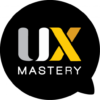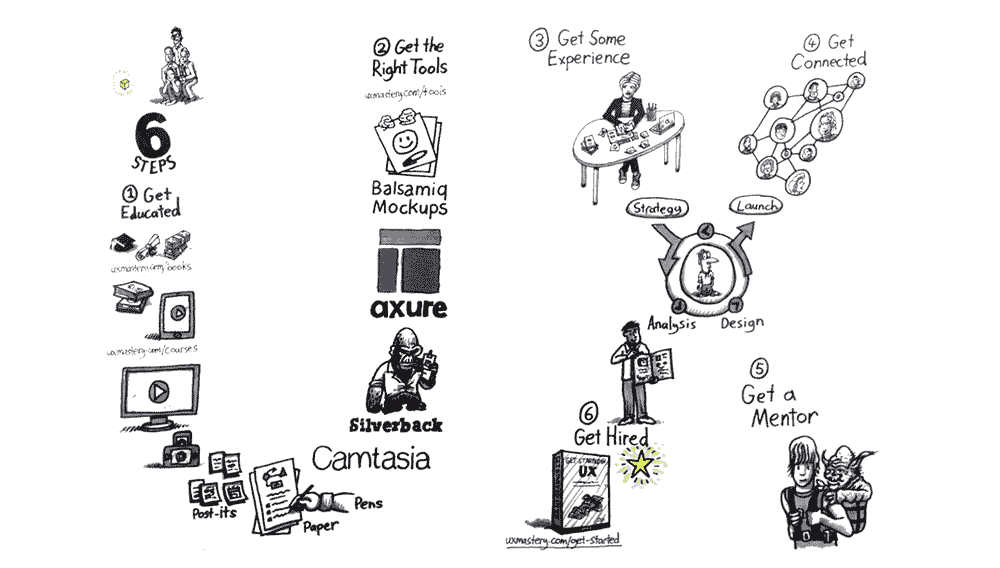Update: Since launching UX Mastery, this has been the most popular article we’ve published by a country mile. As a result, we’ve turned it into an animated video and published an eBook on the topic.
If you’re after more specific advice, be sure to pick up a copy of our ebook, Get Started in UX, the definitive guide to making a career change and landing a job as a user experience designer.
We’ve received quite a few emails lately from readers looking to get started in UX Design—many coming from a print background. Here’s one such email, which I’ve published here with permission:
I’m a traditional print-based graphic designer looking to get into UX design. I’ve a good background in the Adobe Suite and traditional print software (QuarkXpress etc). Currently I’m working within the newspaper industry and am fearing for my future, as the industry is in (probably) terminal decline. I am looking to re-skill towards web-based UX design. Can you recommend a starting point and path I should look to take? Many thanks.
In our animated video (embedded below) I mentioned that a career as a UX Designer is interesting, challenging, rewarding, pays well, and has a low barrier of entry.
What I didn’t touch on is how to get started as a UX Designer. What follows is my advice for anyone looking to get started in UX Design.
Enjoying this article?
Download the book that it inspired from the UX Mastery store. Available in ePub, mobi and PDF formats.
1) Get Educated
I’m not saying you should go invest in a university degree. While I’m certain that there are quality higher education courses out there, I don’t think that’s a necessary step to take to break into the UX world. What I mean is: read, watch and listen to everything you can get your hands on in order to understand how UX Designers do what they do.
We’ve put together a ton of recommended books, which should form a good starting point. If you’re looking for an online course to help you get started, our big list of UX courses is the most comprehensive collection you’ll find. For complete beginners, try Lis Hubert’s UX Basics course or the course Become a UX Designer from Scratch by the Interaction Design Foundation; developers may find Amir Khellar’s Design Your User Experience in 7 Simple Steps more to their liking.
In many of these courses, the subject matter itself isn’t difficult to digest, but there is often a lot to learn. The more you can digest, the better off you’ll be.
2) Get The Right Tools
UX Design is more about working with people than working on your own in front of a screen.
That said, there are two tasks that stand out as being a huge part of what I do: creating interactive wireframes and conducting guerrilla usability testing sessions. Both require software to do properly. I’ve tried a few different applications, but keep coming back to Balsamiq Mockups as my wireframing tool of choice, and I use Silverback (Mac only) for recording my usability testing.
There are plenty of other alternatives to these tools out there; these just happen to be what works best for me. For the most comprehensive list of UX Tools ever, check out our 100+ Awesome Tools For UX Designers.
3) Get Some Experience
Your next step is to find a way to put some of this new-found knowledge into practice. Luckily, it’s possible to do so without having to bluff your way into a job only to discover you’re out of your depth.
Whether it means spending some time after hours helping a friend’s small business, a local non-profit, or a personal project, seek out the opportunity to apply some of the theory, and start getting those runs on the board. It could even be as simple as taking the initiative at work to conduct some user testing sessions, and branching out from there.
Approach an agency or organisation that you have contacts on the inside, and volunteer your time to conduct some usability testing sessions or perform user interviews. While it may go against the grain to admit to being a novice at something (and taking a pay cut to go with that) after you’ve had an established career doing something else, this is a field that is so fast moving that I honestly feel like a year after being “that intern” people would forget that was where you came from, and if you’re adding value then you may be in a good position to renegotiate (or move on to somewhere else that recognises the value you’re adding).
For an activity such as conducting user testing, a handful of sessions is all you need to get the hang of things. Once you’ve introduced that user feedback loop to your project, you can start focussing on developing other skills.
4) Get Connected
The best UX jobs, like all jobs, aren’t advertised. They come through LinkedIn, Twitter, local event meetups, referrals, or are only ever sourced internally. Trusting somebody to own the user experience of a product to somebody, for many organisations, is like trusting them with a newborn baby.
There will be a ton of questions and building trust with the interviewer is key. If the position has come from the result of a conversation in a social setting, or a recommendation from somebody you met, then you’ll already have a head start on building that trust. So get along to your local UX Book Club, find an event on meetup.com, and start following some of the UX thought leaders on Twitter.
5) Get A Mentor
For me, finding a mentor was a real turning point. Even though we don’t catch up as often these days as when we first formalised the mentoring relationship, when I look back now, many of the big decisions I made career-wise happened soon after I found a mentor and he started encouraging me to step out of my comfort zone.
My mentor not only helped shape the process that I use on design projects to this day, he also encouraged me to start giving presentations at conferences and meetups, and to quit the low-paying job that I was in and take control of my career. For that I’m eternally grateful. Finding a mentor can be hard, but hopefully if you’ve done a good job of Step 4, you’ll at least have more people within your circle and a better understanding of who’s who. Hopefully someone will stand out. Failing that, you could try a more formal program such as IAI mentor program or a mentor-led bootcamp like Get a New Job in UX Design by the Interaction Design Foundation.
6) Get Hired
With those ducks all lined up, you’re now in the best possible place to land an awesome job. What’s missing, however, is a portfolio of your work.
Much like a graphic designer would have an A3 portfolio that showcases logos, posters and t-shirts he or she has designed, your portfolio should include examples of the deliverables you’ve produced.
Your portfolio could include wireframes you’ve created, example personas and scenarios you’ve developed, photos of walls covered in post-it notes from affinity diagramming exercises, photos of you conducting a workshop … whatever you need to tell a story about the process you follow, and to help you talk about that process during an interview. If you want help, we recommend the online course called How to Create a UX Portfolio by the Interaction Design Foundation.
Want to hear more? Pick up a copy of our ebook: Get Started in UX.
Where to learn more:
- Recommended UX Books
- See our list of UX Conferences
- Find an Online UX Courses that suits you
- Our giant list of UX Degrees
- The best UX Tools and Software
Related Reading
- Get Started in UX: the complete guide to launching a career in user experience design by Luke Chambers and Matthew Magain
- Whitney Hess’s mind-bogglingly comprehensive collection of resources and guiding principles.
- Patrick Neeman’s list of seven tips on how to get started in user experience
- Nick Finck’s excellent tips on starting a career in user experience design
- UXPin’s collection of free UX books
- A comprehensive (and free) UX course
- A free course on UX Design for mobile developers
- UX Beginner
- UX Apprentice
What other advice do you have for people trying to migrate to UX Design from another career? Let us know in the comments.

